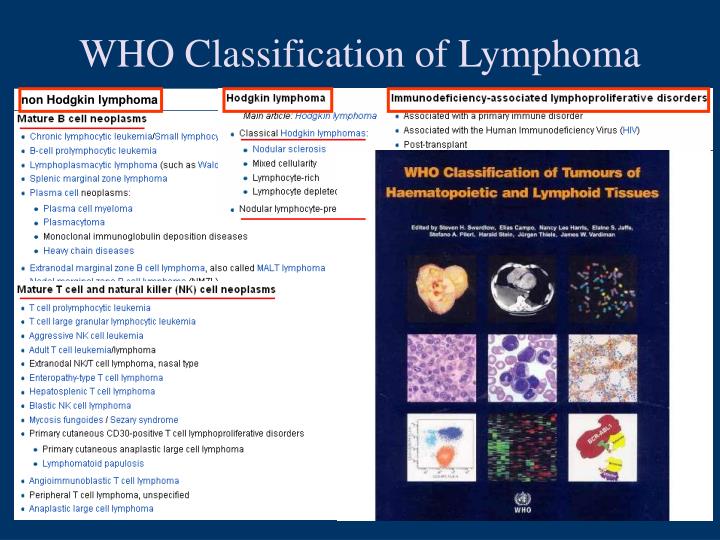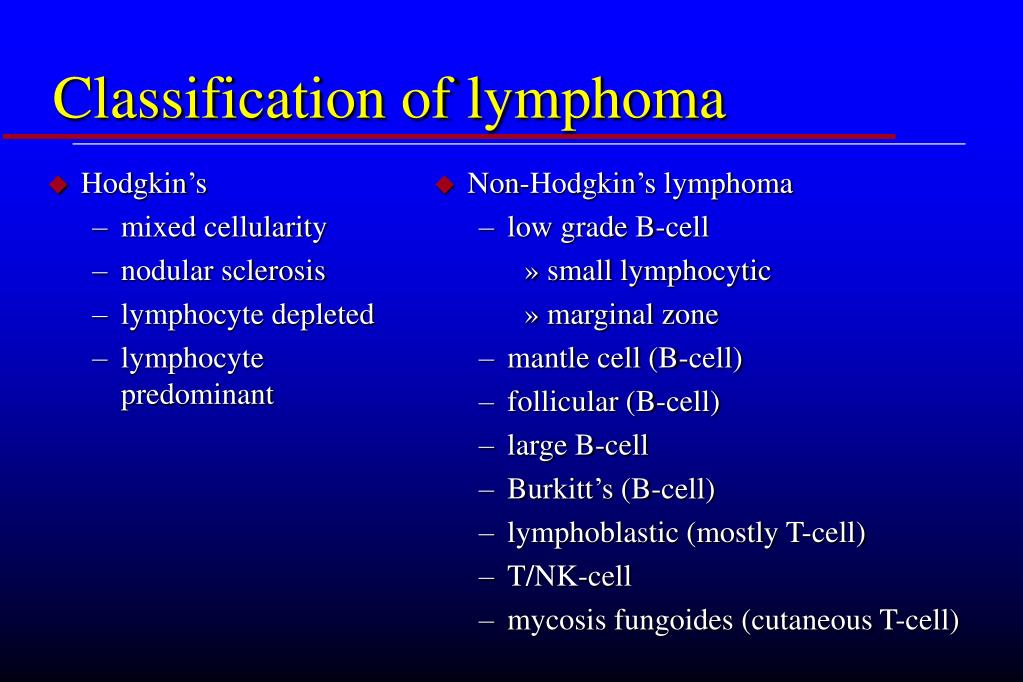Signs and symptoms of lymphoma may include: 1. painless swelling of lymph nodes in your neck, armpits or groin Lymphome Klassifikation 2. persistent fatigue 3. fever 4. night sweats 5. shortness of breath 6. unexplained weight loss. Who lymphoma classification: system of lymphoma types fb tw pn over the years, various classification systems have been used to differentiate lymphoma types including the rappaport classification (used until the 70's), the working formulation, the national cancer institute working formulation, and the revised european-american lymphoma classification (real).
Learn about lymphoma Lymphome Klassifikation from the cancer experts. call city of hope. Eine weltweit akzeptierte klassifikation der malignen lymphome wurde im oktober 1997 durch eine von der who inaugurierte internationale expertengruppe .
Search For Results Searching For Information

Als non-hodgkin-lymphom, kurz nhl, bezeichnet Lymphome Klassifikation man die gruppe aller malignen lymphome, d. h. monoklonaler neoplasien von boder 4 klassifikation.
Factors that can increase the risk of lymphoma include: 1. your age. some types of lymphoma are more common in young adults, while others are most often diagnosed in people over 55. 2. being male. males are slightly more likely to develop lymphoma than are females. 3. having an impaired immune system. lymphoma is more common in people with immune system diseases or in people who take drugs that suppress their immune system. 4. developing certain infections. some infections are associated with The who classification, published in 2001 and updated in 2008, is based upon the foundations laid within the "revised european-american lymphoma classification" (real). this system groups lymphomas by cell type (i. e. the normal cell type that most resembles the tumor) and defining phenotypic molecular or cytogenetic characteristics. The most common form of lymphoma is non-hodgkin lymphoma. it tends to develop in older adults. several types of treatment can be used against non-hodgkin lymphoma, including chemotherapy, radiation therapy, immunotherapy, targeted therapy, and stem cell transplantation. hodgkin lymphoma hodgkin lymphoma is also known as hodgkin’s disease.
Lymphoma Classifications
Jan 03, 2014 · revised european-american classification of lymphoid neoplasms (real): describes the different types of lymphomas as entities, with each type classified according to cell origin, based on morphologic, immunologic and genetic characteristics; introduced in 1994. See full list on mayoclinic. org. Lymphoma develops in different parts of the body, particularly the lymph nodes, and the first manifestation of the disease is swollen, though painless, lymph nodes. there are different types of lymphomas; the most common type is hodgkin’s lymphoma and non-hodgkin’s lymphoma. hodgkin’s lymphomas.
Lymphoma is a cancer of the lymphatic system, which is part of the body's germ-fighting network. the lymphatic system includes the lymph nodes (lymph glands), spleen, thymus gland and bone marrow. lymphoma can affect all those areas as well as other organs throughout the body. many types of lymphoma exist. the main subtypes are: 1. hodgkin's lymphoma (formerly called hodgkin's disease) 2. non-hodgkin's lymphomawhat lymphoma treatment is best for you depends on your lymphoma type and its severit Lymphoma is a type of blood cancer that affects white blood cells called lymphocytes. lymphoma is also called a cancer of the lymphatic system. in lymphoma, something goes wrong with the development of white blood cells called lymphocytes, which are an important part of your immune system. Zation classifications of tumors of the hematopoietic organs. the latest world health organization classification revised in 2017 comprises more than 80 entities of mature lymphoid neoplasms (b-cell, t-cell, and hodgkin lymphomas), which are defined according to their morphology, immunophenotype, genetic lesions and molecular profiles, clinical features, and cellular derivation. the. Who lymphoma classification: system of lymphoma types fb tw pn over the years, various classification systems have been used to differentiate lymphoma types including the rappaport classification (used until the 70's), the working formulation, the national cancer institute working formulation, and the revised european-american lymphoma.
Unter der sammelbezeichnung non-hodgkin-lymphom (nhl) werden alle krebserkrankungen des lymphatischen systems (maligne lymphome) zusammengefasst, die kein morbus hodgkin die derzeit gültige whoklassifikation hat die früher verwendet. Während in der kiel-klassifikation beispielsweise non-hodgkin-lymphome beziehungsweise ihre zellen als hoch maligne oder niedrig maligne qualifiziert . Revised european-american classification of lymphoid neoplasms (real): describes the different types of lymphomas as entities, with each type classified according to cell origin, based on morphologic, immunologic and genetic characteristics; introduced in 1994.


Lymphoma facts city of hope.
Doctors aren't sure what causes lymphoma. but it begins when a disease-fighting white blood cell called a lymphocyte develops a genetic mutation. the mutation tells the cell to multiply rapidly, causing many diseased lymphocytes that continue multiplying. the mutation also allows the cells to go on living when other cells would Lymphome Klassifikation die. this causes too many diseased and ineffective lymphocytes in your lymph nodes and causes the lymph nodes to swell. Mar 16, 2012 maligne lymphome: klinik, klassifikation, therapie und prognose. malignant lymphomas: clinical appearance, classification, therapy and . Some types of lymphoma are more common in young adults, while others are most often diagnosed in people over 55. being male. males are slightly more likely to develop lymphoma than are females.
B-cell lymphoma, unclassifiable, with features intermediate between diffuse large b-cell lymphoma and burkitt lymphoma •criteria vague •eliminated from revised who classification 2016 •all large b cell lymphomas with myc and bcl2 and/or bcl6 rearrangments (double/triple hit) will be included in a single category. The classification of lymphoma is following a similar pattern. initial morphological separation into hodgkin’s disease (now hodgkin’s lymphoma) and non-hodgkin’s lymphoma distinguished entities that had differing clinical behavior, but required further subdivision. initial classification of the non-hodgkin’s lymphomas was again morphological but linked to natural history-defined. Lymphoma is a cancer of the lymphatic system. the lymphatic system helps protect us from infection and disease. it is part of the body’s immune system. there are many types of lymphoma. different types develop and are treated in different ways. a doctor can only find out your lymphoma type by collecting some lymphoma cells and testing them in. Marginal zone lymphomas are categorized by three main types, which account for about up to 10 percent of all lymphomas: mucosa-associated lymphoid tissue (malt) lymphoma: also known as extranodal marginal zone b-cell lymphoma, this is the most common type of marginal zone lymphoma. malt lymphomas often originate in the Lymphome Klassifikation stomach and are linked to.
Non-hodgkin-lymphome amboss.